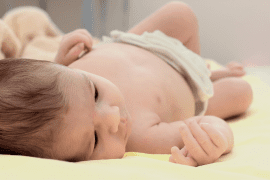The Big Question: How Do You Know When They Need to Go?
Newborn babies, right from the start, can tell their caregivers that they need to eliminate! The good news is that newborn babies frequently urinate while they are awake (often as frequent as every 15 or 20 minutes) and they may do several poos a day. So, you’re bound to catch something if you’re giving EC a go with a newborn! There are some tell tale signs to watch for if you’re trying to figure out your babies signal that it’s time to ‘go’:
- squirming and kicking and grunting
- unexplained fussiness (especially after a feed)
- pulling on and off the breast or bottle during a feed
- almost always upon waking from a sleep
- when you feel them ‘pushing’ and making a funny face (although sometimes that means you may have already missed most of it).
A baby will often arch her back or try to straighten her legs when she is finished eliminating, or if she doesn’t have to go.
Using Sounds and Cues
Many parents who practice EC, like to make a quiet ‘psss’ sound when they notice that their child is urinating. Even if they don’t catch it in time, making the ‘psss’ sound will help the child associate the elimination with the sound. That way, the next time you hold your baby out to eliminate, if you make the ‘psss’ sound, the child will associate the sound with the action of doing a pee. For example, when I was first getting used to doing EC with my older daughter, I would often miss a pee while I was changing her diaper. I would still make the ‘psss’ sound, even though I had missed the pee. I learned very quickly to offer the bucket every time I did a diaper change so that I could save myself from dirtying a diaper. It is extremely common for newborns to eliminate while having a diaper change. Even at such a young age, babies do not like to soil themselves and will often hold it until their diaper is off.
You can also blow raspberries as the sound for doing a poo. When my daughter was only three months old, she would blow a raspberry when she needed me to take her!
While you can make the ‘psss’ sounds and blow raspberries, you certainly don’t have to. With my younger daughter, I hardly ever made the noises. Just holding her in the classic EC squat position was sufficient communication enough to let her know that it was time to go. If they truly have to go and they are given the opportunity, newborns will almost always make use of a potty opportunity (and newborns go so frequently that it’s almost likely something will come out if you hold them in a squat position). Simply observing your child and their body language (fussing, squirming) can tell you a lot about their elimination needs.
Also, patterns, like time of day, or particularly after or during feeds. It’s very common for newborns to have to eliminate mid-feed. I would sometimes breastfeed my newborns with a terry towel wrapped around their bottom, if I had a sneaking suspicion that they had to go. They would often a pause for a second and do a sort of ‘half push’, so I would stop the feed for a second, offer the potty and then keep feeding. Some women don’t even stop the feed, they feed AND take their babies to the loo!
Nighttime EC
Sometimes a frequently waking or squirming baby at night is a sign that they have to eliminate. You can certainly practice EC at night and your baby may sleep much better because of it. I often found that I had to change a diaper anyway at night, so it was almost easier and faster to take my babies to the bucket. Babies who are started on nighttime EC right from the newborn weeks, are less disrupted by EC when they get a little bit older. My girls were so used to me taking them to the potty at night, that they would quite often sleep right through me it! Many mothers keep a potty or bucket right next to where the baby is sleeping so that they can easily feed and EC their babies with minimal disturbance. The benefit of doing nighttime EC is that babies will often start to stay dry through the night at a very young age.










